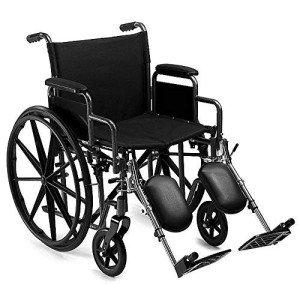Bariatric Wheelchair Seat Width
Seat Width

Having the correct seat width is essential to wheelchair users who invest longer durations in their chairs. Too narrow a seat will trigger pressure on the hips and thighs which might lead to sores or pressure points. Having too broad a seat can also make it hard for the user to reach the hand rims to propel themselves or maneuver in little spaces.
To determine the appropriate seat width an individual would rest on a chair normally and have their measurement taken throughout their lap at the best point which is normally their hips. A wheelchair determining tape can be utilized to determine this, but a backyard stick is preferred as it avoids individuals from wrapping the tape around their hips which would offer an inaccurate result.
The standard wheelchair seat width is 16" (narrow adult), 18" (basic grownup), and 20" (broad grownup). For bariatric clients, a 24" seat is readily available. This heavy-duty extra broad bariatric wheelchair from Medline includes swing-away footrests, a carbon steel frame with rust- and chip-resistant chrome plating, and easy-to-clean vinyl upholstery. It has a weight capacity of 500 pounds.
Seat Depth
Typically, the seat depth of a bariatric wheelchair was added 2" to the measurement taken at the user's largest point (typically their hips). This was implied to accommodate extra layers of clothing that may be used during winter. Nevertheless, this practice is becoming less common as wheelchair users are able to invest more time inside your home and are not wearing long coats. This makes the seat depth of a chair lesser when picking a bariatric wheelchair. Nevertheless, it is still crucial to choose an alternative that provides sufficient assistance for larger users.
The Medline folding extra large bariatric manual wheelchair includes a comfy 24" seat width and a sturdy slide tube silver vein frame. It likewise has an adjustable axle and tool-free elevating legrests.
Seat Height
When it pertains to identifying the correct wheelchair seat width you should always determine from the user's widest point which is usually their hips. lightweight bariatric wheelchair will also require to consider whether the user is going to be using a winter coat as this may include 2" to the width needed.
When a wheelchair is in usage it must just be run on level surfaces with the wheel locks totally engaged. lightweight bariatric wheelchair is to prevent the chair from being able to move inclines that are 10 degrees or higher. It is also crucial to keep in mind that any activity that may move the center of mass in the chair need to be finished with care. This consists of reaching for items that need the person to lean out of their seat or attempting to stand up from it.
Whenever you have the chair in usage it is advised that you routinely examine it for damage and oil any locations that are deemed required. For instance, the casters must be oiled by removing the caster fork and utilizing a multi-purpose grease to use to the caster stem bearings. Also, the foot plates can be changed by loosening up the bolt and after that moving them to the desired position. This permits the feet to sit comfortably on the footplate and prevents any pressure points from forming. This can be really uncomfortable for the user and if left unattended, can result in push sores.
Weight Capacity
Bariatric wheelchairs are developed to support more weight than basic wheelchairs. This makes them stronger and much better equipped to handle falls. They are also typically larger and larger, making them less maneuverable in tight spaces than standard wheelchairs. They require vehicles with unique ramps and lifts to pack them, in addition to drivers who understand how to best transport them from one location to the next.
When picking a wheelchair, consider its weight capacity as it will be the primary determining aspect in whether it will accommodate your traveler's requirements. The weight capacity of the chair is often listed as a fixed load, implying that it shows the amount of weight the chair can comfortably hold while stalling. Nevertheless, some producers also list an active load that is based on a drop test and can replicate the impact of somebody taking a seat in the chair. This may be a more reliable measurement of the weight limit, depending upon your requirements.
If you prepare to carry out activities that move your center of mass in the seat (such as reaching for things), make sure to have front casters pointed in a forward instructions and wheel locks engaged so the chair will not tip over. Also, examine that casters are lubed regularly to prevent extreme wear and abrasions. The lubrication treatment includes eliminating the fork, separating the caster from the wheel, and greasing the caster stem bearings with top quality multi-purpose grease.
